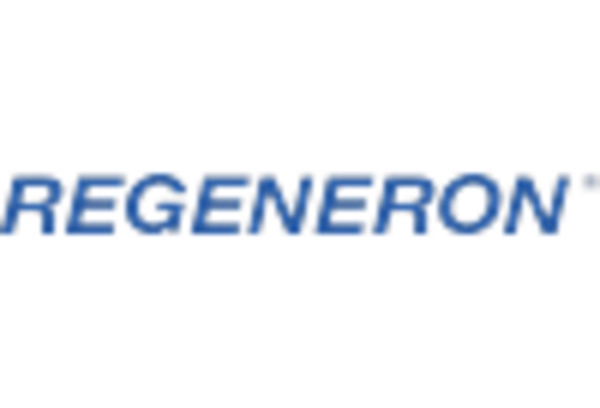Increased Awareness and Screening Initiatives
Heightened awareness regarding eye health and the importance of regular screenings is driving the Ophthalmic Disease Therapeutics Market. Public health campaigns and educational initiatives have led to a greater understanding of eye diseases and their potential impact on quality of life. As a result, more individuals are seeking preventive care and timely treatment, which in turn fuels demand for therapeutic options. The World Health Organization has reported that uncorrected refractive errors and cataracts are among the leading causes of visual impairment, underscoring the need for effective interventions. This growing awareness is likely to sustain market growth as healthcare providers and organizations continue to promote eye health and access to therapeutic solutions.
Aging Population and Rising Incidence of Eye Diseases
The increasing prevalence of age-related eye diseases, such as cataracts and age-related macular degeneration, is a primary driver of the Ophthalmic Disease Therapeutics Market. As populations age, the demand for effective therapeutic solutions escalates. According to recent estimates, the number of individuals aged 65 and older is projected to double by 2050, leading to a surge in eye disease cases. This demographic shift necessitates innovative treatments and therapies, thereby propelling market growth. Furthermore, the rising incidence of diabetic retinopathy, linked to the global diabetes epidemic, further exacerbates the situation. The convergence of these factors indicates a robust market potential for ophthalmic therapeutics, as healthcare systems strive to address the burgeoning needs of an aging population.
Technological Advancements in Ophthalmic Therapeutics
Technological innovations in ophthalmic therapeutics are significantly influencing the Ophthalmic Disease Therapeutics Market. The advent of novel drug delivery systems, such as sustained-release implants and targeted therapies, enhances treatment efficacy and patient compliance. Additionally, advancements in diagnostic technologies, including optical coherence tomography and artificial intelligence, facilitate early detection and personalized treatment plans. The market for ophthalmic therapeutics is projected to witness substantial growth, with estimates suggesting a compound annual growth rate of over 6% in the coming years. These technological strides not only improve patient outcomes but also attract investments from pharmaceutical companies eager to capitalize on emerging opportunities in the ophthalmic sector.
Rising Investment in Ophthalmic Research and Development
The Ophthalmic Disease Therapeutics Market is experiencing a surge in investment directed towards research and development. Pharmaceutical companies are increasingly allocating resources to discover and develop novel therapies for various ophthalmic conditions. This trend is supported by favorable regulatory environments and incentives for innovation, which encourage the development of new drugs and treatment modalities. Recent data indicates that R&D spending in the ophthalmic sector has increased by approximately 10% annually, reflecting a commitment to addressing unmet medical needs. As new therapies emerge, they are expected to enhance treatment options for patients, thereby driving market expansion and improving overall patient care in ophthalmology.
Growing Demand for Personalized Medicine in Ophthalmology
The shift towards personalized medicine is becoming a pivotal driver in the Ophthalmic Disease Therapeutics Market. Tailoring treatments to individual patient profiles, including genetic and environmental factors, enhances therapeutic efficacy and minimizes adverse effects. This trend is particularly relevant in the context of complex eye diseases, where a one-size-fits-all approach may not suffice. The market is witnessing an increase in the development of biomarker-driven therapies, which are designed to target specific patient populations. As healthcare providers adopt personalized treatment strategies, the demand for innovative ophthalmic therapeutics is expected to rise. This evolution in treatment paradigms could potentially reshape the landscape of ophthalmic care, leading to improved patient outcomes and satisfaction.


















Leave a Comment